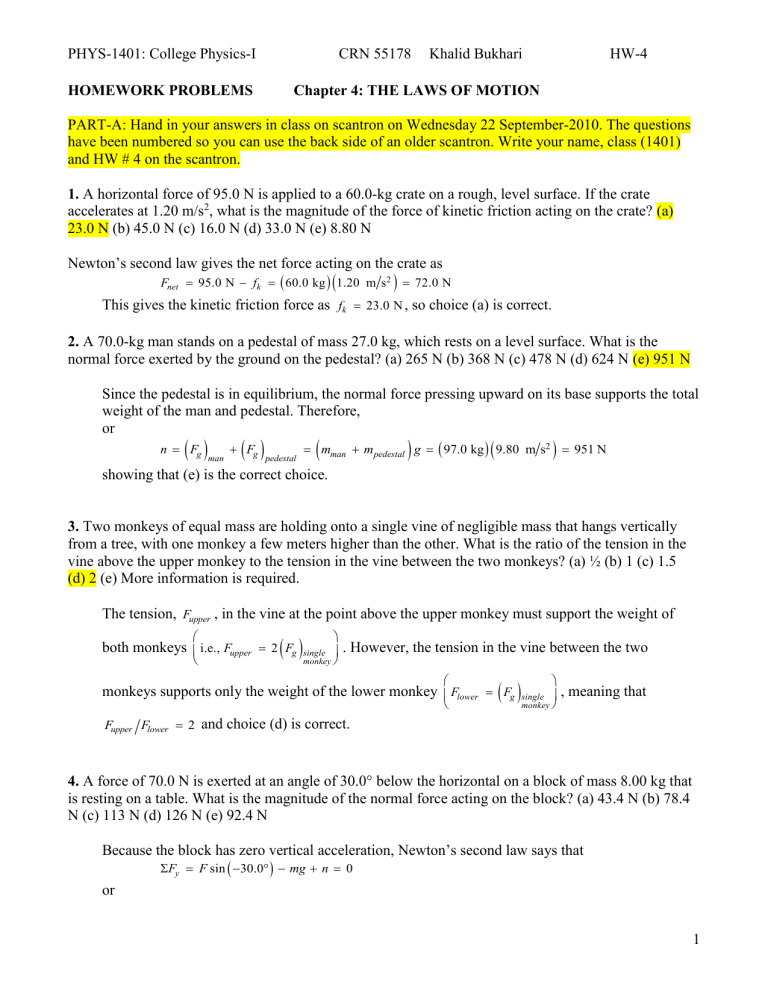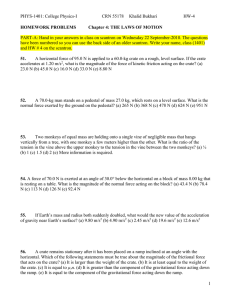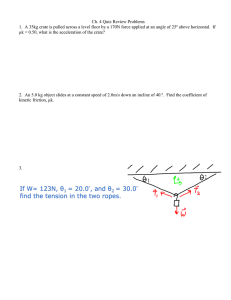CP-S-HW-ch-4.doc

PHYS-1401: College Physics-I CRN 55178 Khalid Bukhari HW-4
HOMEWORK PROBLEMS Chapter 4: THE LAWS OF MOTION
PART-A: Hand in your answers in class on scantron on Wednesday 22 September-2010. The questions have been numbered so you can use the back side of an older scantron. Write your name, class (1401) and HW # 4 on the scantron.
1. A horizontal force of 95.0 N is applied to a 60.0-kg crate on a rough, level surface. If the crate accelerates at 1.20 m/s
2
, what is the magnitude of the force of kinetic friction acting on the crate? (a)
23.0 N (b) 45.0 N (c) 16.0 N (d) 33.0 N (e) 8.80 N
Newton’s second law gives the net force acting on the crate as
F net
95.0 N f k
2
72.0 N
This gives the kinetic friction force as f k
23.0 N , so choice (a) is correct.
2. A 70.0-kg man stands on a pedestal of mass 27.0 kg, which rests on a level surface. What is the normal force exerted by the ground on the pedestal? (a) 265 N (b) 368 N (c) 478 N (d) 624 N (e) 951 N
Since the pedestal is in equilibrium, the normal force pressing upward on its base supports the total weight of the man and pedestal. Therefore, or n
man
pedestal
m man
m pedestal
g
2
951 N showing that (e) is the correct choice.
3. Two monkeys of equal mass are holding onto a single vine of negligible mass that hangs vertically from a tree, with one monkey a few meters higher than the other. What is the ratio of the tension in the vine above the upper monkey to the tension in the vine between the two monkeys? (a) ½ (b) 1 (c) 1.5
(d) 2 (e) More information is required.
The tension, F upper
, in the vine at the point above the upper monkey must support the weight of both monkeys
i.e., F upper
2
monkey
. However, the tension in the vine between the two monkeys supports only the weight of the lower monkey
F lower
F upper
F lower
2 and choice (d) is correct.
monkey
, meaning that
4.
A force of 70.0 N is exerted at an angle of 30.0° below the horizontal on a block of mass 8.00 kg that is resting on a table. What is the magnitude of the normal force acting on the block? (a) 43.4 N (b) 78.4
N (c) 113 N (d) 126 N (e) 92.4 N
Because the block has zero vertical acceleration, Newton’s second law says that
F y
F sin
30.0
mg n 0 or
1
PHYS-1401: College Physics-I CRN 55178 Khalid Bukhari HW-4 n
30.0
2
35.0 N 78.4 N 113 N and we see that (c) is correct.
5. If Earth’s mass and radius both suddenly doubled, what would the new value of the acceleration of gravity near Earth’s surface? (a) 9.80 m/s 2
(b) 4.90 m/s
2
(c) 2.45 m/s
2
(d) 19.6 m/s
2
(e) 12.6 m/s
2
From Newton’s law of universal gravitation, the force Earth exerts on an object on its surface is
F g
2
E
mg , or the acceleration of gravity at Earth’s surface is g GM
E
R 2
E
. If both the mass and radius of the Earth should double, so M
E
2 M
E
and R
E
2 R
E
, the acceleration of gravity at the surface would then be g G
M
E
2
G
2 M
E
4 R
1
2
G
M
E
R
g
2
9.80 m s 2
2
4.90 m s 2
meaning that (b) is the correct answer.
6. A crate remains stationary after it has been placed on a ramp inclined at an angle with the horizontal.
Which of the following statements must be true about the magnitude of the frictional force that acts on the crate? (a) It is larger than the weight of the crate. (b) It is at least equal to the weight of the crate. (c)
It is equal to
µ s n . (d) It is greater than the component of the gravitational force acting down the ramp. (e)
It is equal to the component of the gravitational force acting down the ramp.
When the crate is held in equilibrium on the incline as shown in the sketch, Newton’s second law requires that F x
F y
0 . From
F x
F g x
f s
0 , the magnitude of the friction force equals the component of gravitational force acting down the incline, or choice (e) is correct. Note that f s
f s max
s n only when the crate is on the verge of starting to slide.
8. A manager of a restaurant pushes horizontally with a force of magnitude 150 N on a box of melons.
The box moves across the floor with a constant acceleration in the same direction as the applied force.
Which statement is most accurate concerning the magnitude of the force of kinetic friction acting on the box? (a) It is greater than 150 N. (b) It is less than 150 N. (c) It is equal to 150 N. (d) The kinetic friction force is steadily decreasing. (e) The kinetic friction force must be zero.
9. Four forces act on an object, given by = 40 N east, = 50 N north, = 70 N west, and = 90 N south. What is the magnitude of the net force on the object? (a) 50 N (b) 70 N (c) 131 N (d) 170 N (e)
250 N
Choose a coordinate system with the positive x -direction being east and the positive y -direction being north. Then the components of the four given forces are:
A x
C x
40 N,
70 N,
A y
C y
0
0
B x
D x
0, B
0, y
D y
50 N
90 N
The components of the resultant (or net) force are
R y
A y
B y
C y
D y
R x
A x
B x
C x
D x
30 N and
40 N . Therefore, the magnitude of the net force acting on the object is
2
PHYS-1401: College Physics-I CRN 55178 Khalid Bukhari HW-4
R R 2 x
R 2 y
30 N
2
40 N
2 50 N , or choice (a) is correct.
10. If an object of mass m moves with constant velocity v , the net force on the object is (a) mg (b) mv (c) ma (d) 0 (e) None of these answers is correct.
11. If an object is in equilibrium, which of the following statements is not true? (a) The speed of the object remains constant. (b) The acceleration of the object is zero. (c) The net force acting on the object is zero. (d) The object must be at rest. (e) The velocity is constant.
13. A large crate of mass m is placed on the back of a truck but not tied down. As the truck accelerates forward with an acceleration a , the crate remains at rest relative to the truck. What force causes the crate to accelerate forward? (a) the normal force (b) the force of gravity (c) the force of friction between the crate and the floor of the truck (d) the “ ma
” force (e) none of these
14. Which of the following statements are true? (a) An astronaut’s weight is the same on the Moon as on
Earth. (b) An astronaut’s mass is the same on the International Space Station as it is on Earth. (c) Earth’s gravity has no effect on astronauts inside the International Space Station. (d) An astronaut’s mass is greater on Earth than on the Moon. (e) None of these statements are true.
15. Two objects are connected by a string that passes over a frictionless pulley as in Active Figure 4.18, where m
1
< m
2
and a
1
and a
2
are the respective magnitudes of the accelerations. Which mathematical statement is true concerning the magnitude of the acceleration a
2
of mass m
2
? (a) a
2
< g (b) a
2
> g
(c) a
2
= g (d) a
2
< a
1
(e) a
2
> a
1
PART-B: Hand in your solutions to the following questions in class, on Wednesday 22 September -
2010. Show the detailed calculations. Box your final answers.
17. (a) Find the tension in each cable supporting the 600-N cat burglar in Figure P4.17.
3
PHYS-1401: College Physics-I CRN 55178 Khalid Bukhari
(a) Since the burglar is held in equilibrium, the tension in the vertical cable equals the burglar’s weight of 600 N Now, consider the junction in the three cables:
F y
0 , giving T
2 sin 37.0
600 N 0
HW-4 or
T
2
Also, F x
T
1
0
600 N sin 37.0
997 N in the inclined cable
which yields T
2
cos 37.0
T
1
0 , or
796 N in the horizontal cable
21. Two blocks each of mass 3.50 kg are fastened to the top of an elevator as in Figure P4.21. (a) If the elevator accelerates upward at 1.60 m/s
2
, find the tensions T
1
and T
2
in the upper and lower strings.
(b) If the strings can withstand a maximum tension of 85.0 N, what maximum acceleration can the elevator have before the first string breaks?
(a) Free-body diagrams of the two blocks are shown at the right.
Note that each block experiences a downward gravitational force
F g
2
34.3 N
Also, each has the same upward acceleration as the elevator, in this case a y
1.60 m s 2
.
4
PHYS-1401: College Physics-I CRN 55178 Khalid Bukhari HW-4
Applying Newton’s second law to the lower block: or
F y
ma y
T
2
F g
ma y
T
2
F g
ma y
34.3 N
2
Next, applying Newton’s second law to the upper block:
F y
ma y
T
1
T
2
F g
ma y
or
T
1
T
2
F g
ma y
39.9 N
39.9 N 34.3 N
2
79.8 N
(b) Note that the tension is greater in the upper string, and this string will break first as the acceleration of the system increases. Thus, we wish to find the value of a y
when T
1
85.0 N .
Making use of the general relationships derived in (a) above gives:
T
1
T
2
F g
ma y
F g
ma y
F g
ma y
2 F g
2 ma y or a y
T
1
2 m
2 F g
85.0 N
2.34 m s 2
25. A 5.0-kg bucket of water is raised from a well by a rope. If the upward acceleration of the bucket is 3.0 m/s
2
, find the force exerted by the rope on the bucket.
The forces on the bucket are the tension in the rope and the weight of the bucket, mg
2
49 N . Choose the positive direction upward and use Newton’s second law:
F y
T
ma
49 N y
2
T 64 N
28. Two packing crates of masses 10.0 kg and 5.00 kg are connected by a light string that passes over a frictionless pulley as in Figure P4.28. The 5.00-kg crate lies on a smooth incline of angle 40.0°.
Find the acceleration of the 5.00-kg crate and the tension in the string.
5
PHYS-1401: College Physics-I CRN 55178 Khalid Bukhari HW-4
Let m
1
10.0 kg , m
2
5.00 kg , and 40.0
.
Applying the second law to each object gives m a m g T
[1] and m a T m g sin
[2]
Adding these equations yields m a m a m g T T or a
m
1
m
2 sin m
1
m
2
g so a
10.0 kg
15.0 kg
9.80 m s 2
4.43 m s 2
Then, Equation [1] yields
T
a
10.0 kg
9.80
2 53.7 N
38. Two objects with masses of 3.00 kg and 5.00 kg are connected by a light string that passes over a frictionless pulley, as in Figure P4.38. Determine the acceleration of each object.
6
PHYS-1401: College Physics-I CRN 55178 Khalid Bukhari HW-4
First, consider the 3.00-kg rising mass. The forces on it are the tension, T , and its weight,
29.4 N. With the upward direction as positive, the second law becomes
T 29.4 N
3.00 kg
a [1]
The forces on the falling 5.00-kg mass are its weight and T , and its acceleration has the same magnitude as that of the rising mass. Choosing the positive direction down for this mass, gives
49.0 N T
5.00 kg
a [2]
Solving Equation (2) for a and substituting into [1] gives
T 29.4 N
3.00 kg
5.00 kg
49.0 N T
or 1.60
T and the tension is T 36.8 N
58.8 N
Equation (2) then gives the acceleration as a
49.0 N 36.8 N
5.00 kg
2.44 m s 2
53. Find the acceleration reached by each of the two objects shown in Figure P4.53 if the coefficient of kinetic friction between the 7.00-kg object and the plane is 0.250. b) First, taking downward as positive, apply Newton’s second law to the 12.0 kg block:
F y
12.0 kg
g T
12 .0 kg
a or
T
2 a
[1]
For the 7.00 kg block, we have
F
0 n
and f k n
13.7 N
54.8 N
Taking up the incline as the positive direction and applying Newton’s second law to the 7.00-kg block gives F x
T f
7.00 kg
a , or
7
PHYS-1401: College Physics-I CRN 55178 Khalid Bukhari
7.00 kg
a T 13.7 N 41.3 N
Substituting Equation [1] into [2] yields
7.00 kg+12.0 kg
a 62.7 N or a 3.30 m s 2
HW-4
(2)
8


